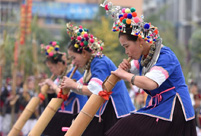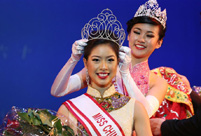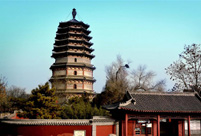


Fossil of the herbaceous angiosperm plant from the mid-Jurassic period (left), recovery plan for the herbaceous angiosperm plant (right). (File Photo)
Paleobotanists have found fossils of the world's earliest herbaceous angiosperm plant from the mid-Jurassic period (more than 164 million years ago) in northern China's Inner Mongolia.
Less than 4 centimeters tall, the fossil’s root, stem, leaves and fruit are well preserved. It was found near the southeast corner of Inner Mongolia by Professor Han Gang of the Paleontological Center of Bohai University in Liaoning Province.
The finding was published in the latest English edition of Acta Geologica Sinica, an academic journal owned by the Geological Society of China.
“The occurrence of fructifications implies that the plant is already mature,” Han said.
“The small size of this mature plant indicates that Juraherba is a herbaceous seed plant, most likely an angiosperm. The seeds enclosed in the fructifications further confirm angiospermous affinity.”
It could be the earliest record of herbaceous seed plants as well as of herbaceous angiosperms.
“Most Western botanists believe that angiosperms originated in the early Cretaceous period (about 125 million years ago), but the discovery of Juraherba bodae moves that date back 40 million years,” Han said.
 China has world's largest high-speed rail network
China has world's largest high-speed rail network Top beauties in Chinese provinces
Top beauties in Chinese provinces 600 people attend Lusheng playing contest in S China
600 people attend Lusheng playing contest in S China Engineer troop builds bridge in real combat conditions
Engineer troop builds bridge in real combat conditions You can urinate in public in Chongqing
You can urinate in public in Chongqing Rice terrace scenery in southwest China's Yunnan
Rice terrace scenery in southwest China's Yunnan 2016 Miss Chinatown USA pageant held in San Francisco
2016 Miss Chinatown USA pageant held in San Francisco Ancient pagodas across China
Ancient pagodas across China Wedding dress show up in the air
Wedding dress show up in the air Top 20 hottest women in the world in 2014
Top 20 hottest women in the world in 2014 Top 10 hardest languages to learn
Top 10 hardest languages to learn 10 Chinese female stars with most beautiful faces
10 Chinese female stars with most beautiful faces China’s Top 10 Unique Bridges, Highways and Roads
China’s Top 10 Unique Bridges, Highways and Roads Foreign Minister sends candid message
Foreign Minister sends candid message Laying off 1.8m workers challenges govt’s plans to cut industrial overcapacity
Laying off 1.8m workers challenges govt’s plans to cut industrial overcapacity Are these new therapeutic devices a medical miracle or the Emperor’s new cloak?
Are these new therapeutic devices a medical miracle or the Emperor’s new cloak? Seeking legal help brings shame on Chinese domestic violence victims despite law
Seeking legal help brings shame on Chinese domestic violence victims despite lawDay|Week